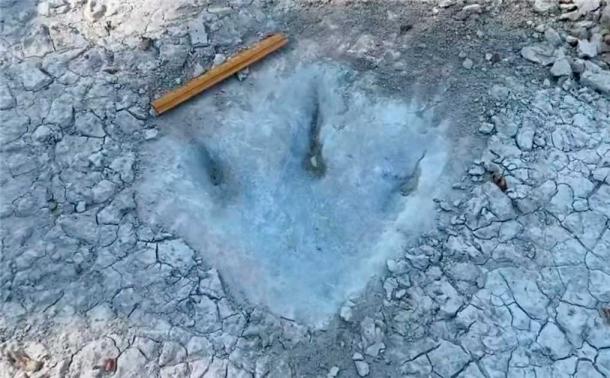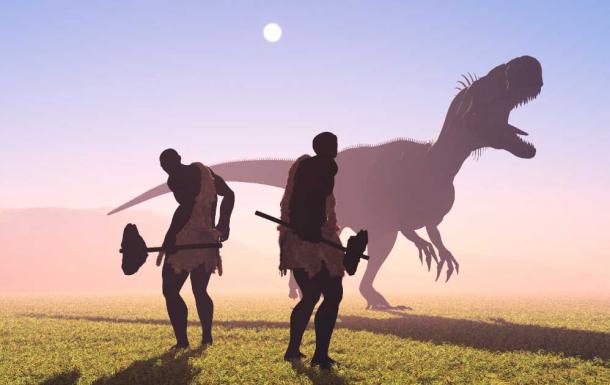
Extreme Drought Exposes Theropod Dinosaur Tracks in Texas River
A record drought in Texas has exposed a bunch of 110-million-year-old dinosaur tracks in yet another example of how climate change is both revealing new things and making us uncomfortable.
As lakes, rivers and streams dry up around the world, archaeological and anthropological gold is being revealed. This was made evident in Europe over the last week after a wealth of finds were reported.
Six days ago The Guardian reported that in the River Elbe, which connects the Czech Republic with Germany, a collection of mysterious 15th century “hunger stones” were revealed. Then, four days ago, Business Insider reported that in the Danube, near the Serbian village of Prahovo, two Nazi shipwrecks from 1944 appeared from the riverbed.
Now, in a freshly dried up riverbed at The Dinosaur Valley State Park in Texas, rare dinosaur tracks of have been exposed, measured, and filmed.

One of the previously discovered theropod dinosaur footprints discovered at Dinosaur Valley State Park in Glen Rose, Texas. (Dinosaur Valley State Park)
Rare Dinosaur Tracks On The Cretaceous Dino Highway of Texas
This summer has seen a severe lack of rain and record high temperatures in Texas. The Texas Tribune reports “27 percent of Texas is under an “exceptional drought warning while a further 62 percent is enduring an extreme drought.”
A report in IFLScience said the Dinosaur Valley State Park in Texas “was like a prehistoric highway in the early Cretaceous Period” but it is only after the recent severe droughts in the Paluxy River that silt was revealed in shallow water, in which the giant footprints were spotted.
- Looted Ancient Roman Bust Found In Texas Thrift Shop
- 16,700-Year-Old Tools Found in Texas Change Known History of North America
The dinosaur tracks were first discovered in the early 20th century following a massive flood on the Paluxy River. At that time, paleontologists described three-toed theropod prints but later research also identified sauropod footprints which represent the first distinct sauropod tracks ever discovered, anywhere. So why here?
Texas Was T-Rex Turf But There Are Many Kinds of Theropods
According to the Bureau of Economic Geology website, about 120 million years ago in Texas bays and lagoons on the west shore of a shallow sea, dinosaurs walked across muddy-lime sediments. Fine silt and clay sediments then washed in from land areas to the north and west and buried the tracks beneath lime sand bars, which quickly cemented into hard limestone. Over the last 100 million years erosion of the Paluxy River has stripped off the softer shale but has left the limestone ledges in which the prints were identified.
A video posted to Facebook by the Friends of Dinosaur Valley State Park shows each of the dinosaur footprints. The big, deeply embedded, claw marks indicated that the prints were made by a theropod. This family of ancient monsters represents a group of diverse bipedal dinosaurs that is best known for including Tyrannosaurus rex.

Size comparison of selected giant theropod dinosaurs, which include T-Rex (blue), which is clearly not as big as the green Giganotosaurus. (KoprX / CC BY-SA 4.0)
Tracking The High Spined Lizard
Measuring over 30 centimeters (11.81 inches) each, from heel to claw, these new tracks are too small for T-rex, and were created by its cousin, Acrocanthosaurus.
According to ABCDino this “very large genus” was first discovered in Atoka County, Oklahoma in the 1940s, but it also roamed the ancient plains of what are today the states of Wyoming and Texas, around 110 million years ago.
The UK’s Natural History Museum refers to this particular creature as “an enormous carnivore” and its physical description is locked within its name. Pronounced “ah-kroh-kan-tho-sore-us,” this means “high-spined lizard,” a name chosen after scientists calculated it was 11 meters (36 feet) long.
However, as fascinating as these tracks are, they’ll have to go a long way to compete with the “twin sets of tracks” discovered in 1908 in limestone deposits along the Paluxy River, that brought the academic world to a standstill.

Some scholars argued that archaic humans and dinosaurs co-existed for a while. (Kovalenko I / Adobe Stock)
Did Archaic Humans And Dinosaurs Co-exist?
In 1908 it was clear that one of the sets of tracks was left by a giant dinosaur. However, the second set of prints was much smaller, and they were interpreted as “human,” sparking the debate as to whether humans and non-avian dinosaurs lived at the same time, or not?
Shocked, two leading anti-creationists, D. H. Milne, and S. D. Schafersman, at that time pushed back and wrote “such an occurrence, if verified, would seriously disrupt conventional interpretations of biological and geological history and would support the doctrines of creationism and catastrophism,” stated the Milne and Schafersman report.
- New Mexico Mammoth Bones from 37,000 years ago “Upend” Clovis Theory
- Whole Rattlesnake Including Fangs Found Inside Lump of Fossilized Human Poo
Eventually, after a long professorial fight, the second track was officially recognized as having been created by a small dinosaur. Notwithstanding, the modern Institute of Creation Research still finds a way to use these twin-prints to their advantage.
The institute’s website currently says that while the second set of prints are “too ambiguous to be used as an anti-evolution argument, they just might be coming into their own as good evidence for Flood catastrophism.”
Top image: These rare dinosaur tracks were exposed to the light, as it were, by extreme dryness in a Texas riverbed gone dry. Source: Texas Parks & Wildlife Department
By Ashley Cowie
References
Milne, D. H. and Schafersman, S. D. 1983. Dinosaur Tracts, Erosion Marks and Midnight Chisel Work (But No Human Footprints) in the Cretaceous Limestone of the Paluxy River Bed, Texas. Journal of Geological Education. 31 (2): 111-123.
















Comments
Agree, the establishment approach is highly dubious. But look into what China is now doing, cloud seeding to address their droughts. They’re not or no longer controlled by the globalist institutions. If somehow the world could get together and commit to stable weather, blue skies and afternoon rain showers (like it was when I was just a kid!), using a Tesla-influenced total planetary approach, it MIGHT become wonderful!
Nobody gets paid to tell the truth.
"...yet another example of how climate change is both revealing new things and making us uncomfortable."
Making us uncomfortable is the goal. That's why Texas suffers a drought (it's a natural La Nina occurrence), while Australia suffers flooding from the same natural processes. Yet, Australia is the one cloud-seeding now to create more rain, along the heavily populated mid-east coastal strip between Wollongong and Brisbane, flooding people out and destroying agricultural production.
They don't cloud-seed during droughts. That would cause people to be less uncomfortable and less fearful.
There is much that could be feared, but CO2 is about as dangerous as a long-dead dinosaur. Anthropogenic climate change exists, but it is not what most think it is.
The only way I can think of where footprints could be fossilized is where they are made in mud, quickly frozen, then remained frozen for thousands of years. The last Ice Age left some examples, such as the cart tracks in Turkey and around the Med. They say there were previous Ice Ages, so the same dynamic is likely. The last one came on ‘suddenly’ as per scientific consensus, which suggests a sudden global calamity as the cause. If there was one, others are possible if not likely.
Nobody gets paid to tell the truth.